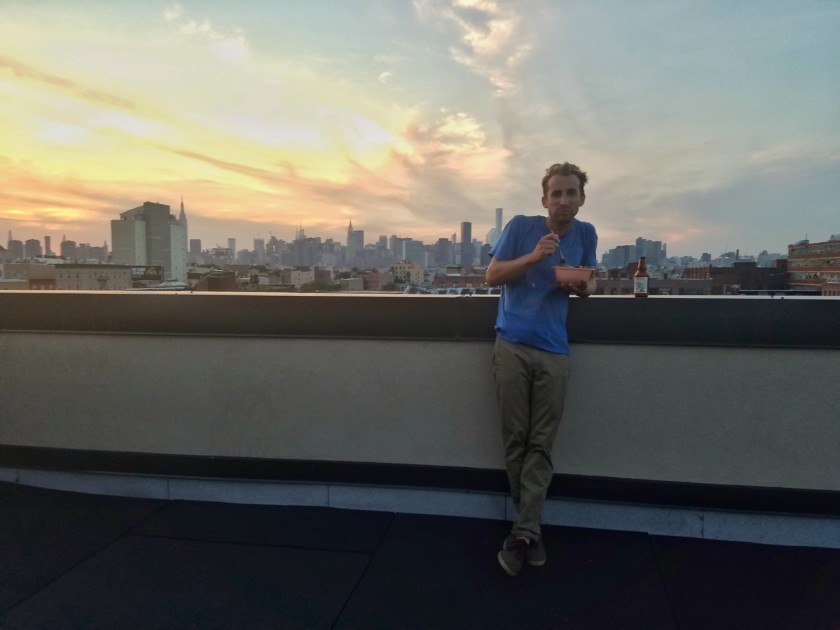Like many contemporary New York artists, Tyler Weeks works long hours at a day job to pay his bills. “I try to get into the studio a few nights a week, and sometimes on weekends,” said Weeks. He was standing in the kitchen of the Greenpoint walkup he shares with two roommates, slicing an avocado for a pasta dish he said he had learned from a fisherman in his home state, Maine.
“I have this great studio that’s really close to my house, in a great neighborhood, but I can only get there so often,” he said. The 31-year-old—who uses the designation “goofball figurative abstraction” to describe his bright, playful oil paintings—works full time at a design/build firm for landscape architecture, leaving him scant time to work on his art.
These workaday intervals, however, advantage Weeks in a way he didn’t expect: forced to muse on his paintings at a remove, he says he often finds himself making more considered aesthetic choices than he otherwise might have. “It makes you slow down a little bit. I end up working on the same painting for, like, a month,” Weeks said. “I end up thinking about it during the day, and I’m excited to get back to it.”
As he waited for a pot of ziti to boil, Weeks described his hometown of Castine, Maine. Situated on a peninsula two-thirds up the Maine coast, Castine’s winter population of roughly 600 quadruples during the tourist season. In the post-hippie era, the region attracted homesteaders and back-to-the-landers eager to start new lives close to nature. As a fledgling artist, Weeks was inspired by the creative adults surrounding him.
“A lot of the kids I grew up with, their parents had moved there in the seventies, trying to farm or live these alternative lifestyles,” Weeks explained. “A lot of parents didn’t have clear-cut professions or jobs. It was kind of like: ‘John’s dad is a painter, maybe I’ll be a painter.’”
There was a good deal of support for the arts in Castine and the surrounding communities, Weeks added, noting that Maine has a long tradition of harboring retreating artists—painters like Winslow Homer and the Wyeth family were among the many artists who escaped to Maine to work.
In Castine, Weeks completed several apprenticeships with local artists and craftspeople, as well as a residency at the venerable Haystack Mountain School of Crafts, founded in 1950. However, despite coastal Maine’s relatively robust art culture, Weeks—like most young Mainers—decided it was time to strike out for opportunities elsewhere.
Maine’s dearth of year-round jobs is one factor that drives young people out of the state, Weeks said, taking the pasta off the stove and pouring it through a strainer. “It’s kind of your classic brain-drain scenario, where people just leave.”
After studying painting in Virginia, Weeks relocated to New York, where he was impressed by the availability of art he had long admired. “It’s sort of wild being in New York, because you can actually go and see the work firsthand,” Weeks said.

As he mixed the cooked ziti with pesto, spinach, and other vegetables, Weeks discussed some of the painters who have influenced his work. His canvasses, he said, draw on the mutated figures of Dana Schutz; the bold, flat color fields of portraitist Alex Katz; and Fairfield Porter’s sense of wonder. These influences are complemented by Weeks’s coarse brushstrokes and peculiar sense of humor. (One piece shows an anthropomorphic grinning pineapple with a banana for a nose—sort of Arcimboldo meets Sponge Bob Square Pants.)
“I’d say there’s some whimsy, some humor,” Weeks said of his work: “Figures in space, performing different acts that are kind of absurd.”
Once dinner was ready—the finished meal was pasta with pesto, spinach, tomatoes, and avocado—Weeks retired to the roof of his low-rise apartment building to dine. The converted factory containing Weeks’s studio could be seen a few blocks to the east. In the west, the sun set behind the Manhattan skyline.
“I stole this recipe from a guy I used to live with up in Maine. He’s a fisherman,” Weeks said. “He puts pine nuts in it, which I’m missing.”


Leave a Reply